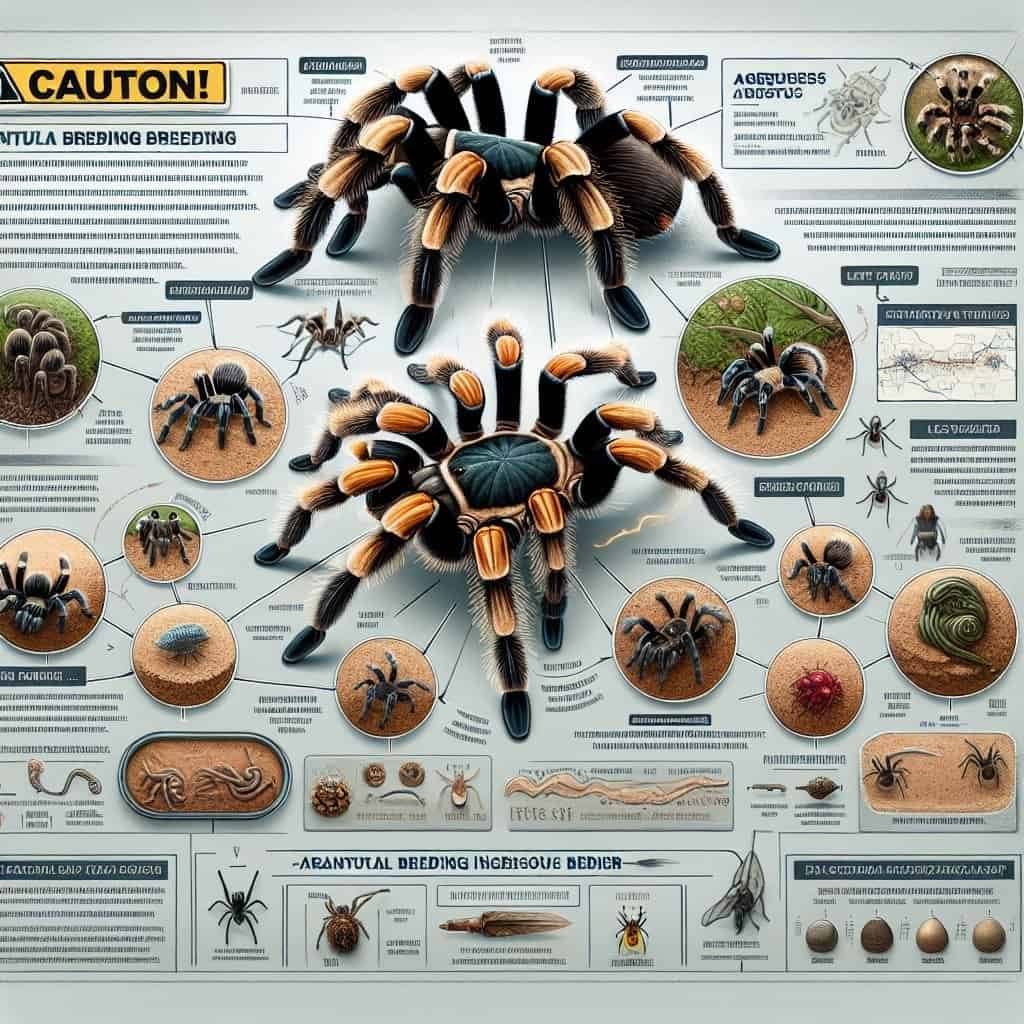Are you considering venturing into the fascinating world of tarantula breeding? If so, you may be curious to know about the potential risks associated with this endeavor and how you can minimize them. Tarantula breeding comes with its own set of challenges and precautions, but with the right knowledge and precautions, you can mitigate these risks and create a safe and successful breeding environment for these intriguing arachnids. In this article, we will explore the potential risks involved in tarantula breeding and offer valuable tips on how to minimize these risks, allowing you to embark on this exciting journey with confidence and peace of mind.

Health risks
Allergic reactions
When it comes to tarantula breeding, one of the potential health risks is allergic reactions. Some individuals may have allergies to the venom, hairs, or excretions of tarantulas. These allergens can cause symptoms such as itching, rashes, difficulty breathing, and even anaphylaxis in severe cases. To mitigate this risk, it is important to be aware of any existing allergies before engaging in tarantula breeding. If you have a known allergy, it is best to avoid direct contact with tarantulas or ensure proper protective measures such as gloves and masks are used.
Venomous bites
Another health risk associated with tarantula breeding is the possibility of venomous bites. While tarantula bites are generally not fatal to humans, they can cause intense pain, swelling, and discomfort. In rare cases, individuals may have an adverse reaction to the venom, leading to more severe symptoms. To minimize the risk of venomous bites, it is essential to handle tarantulas with care and expertise. Proper training and knowledge on handling techniques can help prevent accidental bites and reduce the chances of venomous encounters.
Transmission of diseases
Tarantulas, like any living organism, can carry and transmit diseases. While the transmission of diseases from tarantulas to humans is rare, it is still a risk that should be considered. Some diseases that tarantulas can potentially transmit include viral infections, bacterial infections, and even fungal infections. To mitigate the risk of disease transmission, it is crucial to maintain proper hygiene and sanitation practices in the breeding facility. Regular cleaning and disinfection of enclosures, as well as avoiding cross-contamination, can lower the chances of disease transmission.
Environmental risks
Escape of tarantulas
The escape of tarantulas can pose both environmental and safety risks. Tarantulas are highly skilled climbers and can find their way out of poorly secured enclosures. When a tarantula escapes, it not only disrupts the natural ecosystem but can also potentially harm other animals or humans it comes into contact with. To minimize the risk of escape, it is crucial to ensure that the enclosures are secure and escape-proof. This includes using appropriate containment protocols, such as secure lids and seals, as well as regular checks to ensure there are no gaps or openings where a tarantula can slip through.
Invasion of native species
When tarantulas escape into the natural environment, they can become invasive species. In areas where they are not naturally found, tarantulas can disrupt the local ecosystem by outcompeting native species for resources and potentially causing their decline. This can have far-reaching consequences for the balance of the ecosystem. Mitigating the risk of invasion involves not only preventing escapes but also being aware of the potential impact of introducing non-native tarantulas into new environments. It is crucial to understand the ecological implications and adhere to regulations and guidelines regarding the breeding and release of tarantulas.
Habitat destruction
The breeding of tarantulas in captivity requires suitable enclosures and habitats. However, the sourcing of materials for these enclosures can have negative environmental impacts. For instance, the collection of certain woods for enclosure structures may contribute to deforestation or habitat destruction. To mitigate this risk, it is important to make environmentally responsible choices when selecting materials for enclosures. Opting for sustainable and ethically sourced materials can help prevent further habitat destruction and minimize the ecological footprint associated with tarantula breeding.
Breeding facility risks
Inadequate ventilation
Proper ventilation is crucial in a tarantula breeding facility to maintain a healthy environment for both the tarantulas and the breeders. Inadequate ventilation can lead to the buildup of stagnant air, high humidity levels, and the presence of harmful gases or pollutants. To mitigate this risk, it is important to design and maintain the breeding facility with appropriate ventilation systems. This includes ensuring proper air exchange, filtration to remove particles and odors, and monitoring of humidity levels to create an optimal environment for the tarantulas.
Temperature and humidity control
Tarantulas are sensitive to variations in temperature and humidity. Fluctuations outside their preferred range can negatively affect their health, breeding success, and overall well-being. Maintaining proper temperature and humidity levels in the breeding facility is essential to mitigate this risk. This can be achieved through the use of thermostats, heating pads, humidifiers, and regular monitoring. Creating a stable and controlled environment ensures the comfort and health of the tarantulas, as well as optimal breeding conditions.
Unsafe handling of tarantulas
Handling tarantulas can be risky if not done properly, both for the tarantulas themselves and the breeders. Tarantulas have delicate bodies and can be easily injured if mishandled. Additionally, inexperienced or careless handling can lead to bites or stings, posing health risks for the breeder. To mitigate the risk of unsafe handling, it is crucial to receive proper training and education on handling techniques specific to tarantulas. Additionally, using safety equipment such as gloves and tools designed for tarantula handling can minimize the chances of accidents and injuries.
Genetic risks
Inbreeding depression
Inbreeding among tarantulas can lead to genetic issues and reduced fitness in offspring. Inbreeding depression refers to the loss of vigor and health associated with mating closely related individuals. It can result in reduced fertility, increased susceptibility to diseases, and overall weakened genetic diversity. To mitigate the risk of inbreeding depression, it is essential to maintain a diverse breeding stock and avoid breeding closely related individuals. By introducing new bloodlines and carefully selecting breeding pairs, genetic diversity can be preserved, and the risk of inbreeding-related issues can be minimized.
Reduced genetic diversity
The breeding of tarantulas in captivity can lead to a reduction in genetic diversity. Limited genetic diversity increases the vulnerability of tarantulas to diseases, environmental changes, and other stressors. To mitigate this risk, it is important to promote breeding programs that prioritize genetic diversity. This can be achieved by exchanging breeding stock with other breeders, participating in cooperative breeding programs, and avoiding excessive reliance on a few individuals for breeding purposes. By actively maintaining and promoting genetic diversity, the overall health and resilience of tarantula populations can be enhanced.
Hereditary diseases
Inherited diseases can be a risk in tarantula breeding programs. Certain genetic disorders or conditions can be passed down from parent tarantulas to their offspring, leading to health problems and reduced quality of life. To minimize the risk of hereditary diseases, it is crucial to carefully select breeding pairs and screen them for any known genetic issues. Regular health checks, genetic testing, and consultation with experienced breeders or veterinarians can help identify any potential hereditary concerns and guide responsible breeding practices.

Legal and ethical risks
Licensing and permits
Breeding and keeping tarantulas may be subject to specific legal requirements and regulations depending on the jurisdiction. It is important to familiarize oneself with the applicable laws and obtain the necessary licenses or permits to ensure compliance. Failure to adhere to legal obligations can result in penalties, fines, or even seizure of tarantulas. Mitigating the legal risks involves thorough research into local laws governing tarantula breeding and ensuring proper documentation and permits are obtained to engage in breeding activities legally and responsibly.
Animal welfare considerations
As with any captive animal breeding, ethical considerations and animal welfare must be prioritized in tarantula breeding programs. It is essential to provide an appropriate and enriched environment that meets the physical and psychological needs of the tarantulas. This includes proper nutrition, access to suitable shelter and hiding spaces, and opportunities for natural behaviors. Breeding programs should also prioritize the well-being of the tarantulas over excessive production or profit. Regular monitoring of the tarantulas’ health, socialization, and enrichment activities can help ensure their welfare is upheld.
Abandonment and overpopulation
A potential risk associated with tarantula breeding is the likelihood of abandonment or overpopulation. Breeding without proper planning or consideration for the number of offspring produced can lead to an oversupply of tarantulas without enough demand or suitable homes. This can result in individuals being neglected, abandoned, or released into unsuitable environments. To mitigate this risk, responsible breeding practices should be followed, including careful consideration of the number of offspring produced, responsible marketing and distribution, and education about responsible pet ownership. Breeders should be prepared to provide support and guidance to potential owners to prevent abandonment and promote responsible ownership.
Risk mitigation strategies
Proper training and knowledge
Mitigating risks in tarantula breeding starts with acquiring proper training and knowledge. It is important to research and learn about tarantula biology, behavior, husbandry requirements, and breeding techniques. Engaging in educational programs, attending workshops or seminars, and seeking guidance from experienced breeders or experts in the field can provide valuable insights and help avoid common pitfalls. By arming yourself with knowledge, you can make informed decisions and minimize potential risks associated with tarantula breeding.
Safety equipment and protocols
Using appropriate safety equipment and protocols is crucial to mitigate risks in tarantula breeding. This includes wearing gloves, masks, and protective clothing when handling potentially venomous or allergenic species. Safety equipment acts as a barrier and reduces the chances of accidental bites or exposure to allergens. Additionally, having established protocols for handling and containment can help minimize the risk of escapes, injuries, and the spread of diseases. By implementing safety measures and adhering to established protocols, the risks associated with tarantula breeding can be significantly reduced.
Quarantine procedures
Implementing quarantine procedures is an important risk mitigation strategy in tarantula breeding. Quarantine refers to the isolation and monitoring of newly acquired or potentially sick individuals to prevent the spread of diseases. New tarantulas should undergo a quarantine period in a separate enclosure before being introduced into the breeding population. This allows for observation of any signs of sickness or disease and prevents the introduction of potentially contagious individuals. Proper quarantine procedures, including regular health checks and observation, help identify and address potential health risks before they can affect the breeding population.

Health risk mitigation
Avoidance of allergens
To mitigate health risks associated with tarantula breeding, individuals with known allergies should avoid direct contact with tarantulas and their allergens. This includes refraining from handling tarantulas without proper protective gear and minimizing exposure to tarantula hairs, venom, or excretions. It is important to maintain a clean and dust-free environment in the breeding facility to reduce the dispersal of allergens. Regular cleaning and use of appropriate protective measures, such as gloves and masks, can help minimize the risk of allergic reactions.
Proper handling techniques
Adhering to proper handling techniques is essential to minimize the risk of bites or stings and to ensure the safety of both the tarantulas and the breeders. Handling should only be done by individuals with the necessary knowledge and experience. This includes techniques such as using gentle and slow movements, providing suitable support for the tarantula’s body, and avoiding unnecessary stress or provocation. By following proper handling techniques, the risk of accidental bites or injuries can be significantly reduced.
Seeking medical attention
In the event of a tarantula bite or exposure to allergens resulting in an allergic reaction, seeking immediate medical attention is crucial. Everyone involved in tarantula breeding should be aware of the potential risks and know how to identify symptoms of an adverse reaction. If any signs of an allergic reaction, such as difficulty breathing, swelling, or severe pain, occur after contact with tarantulas, medical attention should be sought promptly. Early intervention can prevent complications and ensure proper treatment.
Environmental risk mitigation
Secure enclosures
To mitigate the risk of tarantula escapes and subsequent environmental disruptions, secure enclosures should be used. This involves ensuring that the enclosures are escape-proof, with tight-fitting lids and appropriate seals. Regular inspection and maintenance of the enclosures are necessary to identify and fix any potential weaknesses or gaps that can allow a tarantula to escape. By providing secure enclosures, the risk of accidental releases and the negative impact on the natural environment can be minimized.
Proper containment protocols
Implementing proper containment protocols is essential to prevent the spread of tarantulas beyond the breeding facility. This includes ensuring that all breeding activities take place within controlled and enclosed areas. Breeding stock should be kept separate from potential escape routes or areas accessible to other animals or humans. Proper containment protocols should also be followed during transportation of tarantulas to prevent accidental releases. By strictly adhering to containment measures, the risk of tarantula escapes and subsequent invasion of native species can be effectively mitigated.
Preventing escape and release
Preventing escapes and releases is a key aspect of mitigating environmental risks associated with tarantula breeding. In addition to using secure enclosures and following proper containment protocols, certain precautions can be taken to further reduce the risk. These precautions include regular checks of enclosures for any signs of damage or weakness, implementing escape barriers such as fine mesh screens or sealants, and establishing emergency plans in case of escapes. By actively taking preventive measures, the chances of tarantula escapes and potential negative impacts on the environment can be significantly reduced.

Breeding facility risk mitigation
Well-ventilated enclosures
Proper ventilation is crucial in tarantula breeding facilities to maintain a healthy and optimal environment for the tarantulas. Well-ventilated enclosures help prevent the buildup of stagnant air, excessive humidity, and the accumulation of harmful gases or pollutants. It is important to design the enclosures with ventilation systems that provide adequate air exchange while maintaining suitable temperature and humidity levels. Regular monitoring of ventilation systems and maintaining clean air filters can ensure a continuous supply of fresh air and mitigate the risk of respiratory issues in tarantulas.
Temperature and humidity monitoring
Regular monitoring of temperature and humidity levels is vital to create and maintain optimal conditions for tarantula breeding. Fluctuations in temperature and humidity can be harmful to tarantulas and impact breeding success. Monitoring devices such as thermometers, hygrometers, and digital gauges should be utilized to consistently track conditions within the breeding facility. Based on the readings, adjustments can be made using heating pads, humidifiers, or environmental control systems to maintain stable and appropriate temperature and humidity levels.
Safe handling practices
Mitigating the risk of accidents and injuries during handling is crucial for both the safety of the breeder and the well-being of the tarantulas. Safe handling practices include using appropriate tools, such as catch cups or handling tubes, and wearing protective gear like gloves and masks. Tarantulas should be handled gently and with minimal stress to avoid accidental drops or bites. Breeding facility personnel should receive proper training on safe handling techniques specific to tarantulas. By implementing safe handling practices, the risk of accidents and injuries can be significantly reduced.
Legal and ethical risk mitigation
Obtaining required licenses and permits
To mitigate legal risks associated with tarantula breeding, it is essential to obtain any required licenses and permits. Researching and understanding the specific legal requirements and regulations surrounding the breeding of tarantulas in your jurisdiction is crucial. This may include acquiring permits for breeding, selling, or transporting tarantulas, as well as adhering to any restrictions or regulations regarding species conservation. By obtaining the necessary licenses and permits, breeders can ensure compliance with the law and minimize legal risks.
Ensuring proper care and welfare
Maintaining proper care and welfare of the tarantulas is not only an ethical responsibility but also a means of risk mitigation. It is essential to provide a suitable environment, nutritionally balanced diet, and regular health checks for the tarantulas in the breeding facility. Consistent monitoring of the tarantulas’ physical and behavioral well-being helps identify any potential health issues early on and allows for timely intervention. By prioritizing proper care and welfare, the risk of health problems, reduced breeding success, and negative impacts on tarantula populations can be minimized.
Promoting responsible pet ownership
Mitigating the risk of abandonment and overpopulation involves promoting responsible pet ownership within the tarantula breeding community. This includes educating potential owners about the requirements and responsibilities of keeping tarantulas as pets. Providing accurate information about tarantula care, appropriate enclosures, and potential health risks can help potential owners make informed decisions. Encouraging responsible breeding practices, such as limiting the number of offspring produced and ensuring proper distribution through reputable channels, can also help mitigate the risk of overpopulation and subsequent abandonment. By fostering a culture of responsible pet ownership, the risks associated with tarantula breeding can be significantly reduced.

